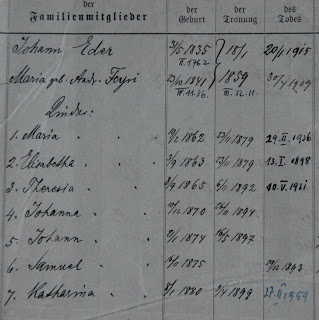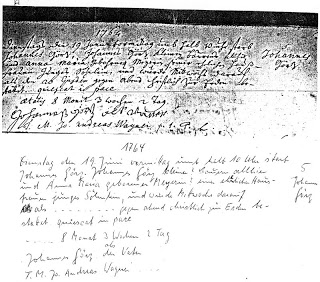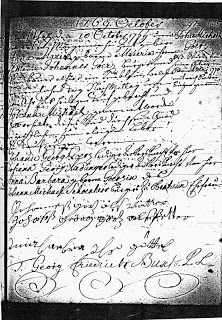The first Görz to arrive in my grandparents’ homeland of Siebenbürgen/Transylvania made the 1,000 mile trek from Gerstheim in Alsace in May, 1770, but to Grosspold, not Neppendorf as the Lutheran church records there had stated. It was the baby on this journey that ended up being the first Görz, later Gärtz to populate Neppendorf, my grandfather’s home town.
In the last post we found out that my cousin Maria obtained copies of four microfilmed entries from the Gerstheim Evangelical Lutheran Church in Alsace, whence came Johannes Görz my grandpa Josef’s great, great grandfather (my g-g-g-g-grandfather).

19th Century church records from Grosspold. Easy to read compared to older church records from Gerstheim in Alsace (see below)
But these documents were much more challenging to make out than the church family books, such as shown at right, which we saw in Lisi Ebner’s Grosspold church, laying out birth (der Geburt), marriage (der Trauung), and death (des Todes) in nice neat columns.
Instead, Gerstheim church documents are divided into separate books labeled:
“Marriages”
“Births/Baptisms” [Recorded together as baptism occurred as soon after birth as possible to preclude immediate baby damnation!]
“Deaths.”
Each life event was worthy of at least a paragraph of indecipherable handwriting—not just a dated entry, which makes them rich sources of family information—if you can find someone to de-code the writing.
First off, Görz, Goerz, Goerz, and Görz all seem to have been accepted spelling of this family’s surname in the Gerstheim records, and all would be pronounced identically. (I never knew about this varied spelling before my trip to Romania in 2007).
Among the four records cousin Maria had received from the Gerstheim, was the marriage, with all the details written out in longhand. Here’s the most important information, as deciphered from the unreadable German script by Meta, my Rosetta Stone in Germany:
MARRIAGE REGISTER FOR 1753
In the upper left corner is the identification, separated from the paragraph of information so one can quickly scan the documents to find a name, it states:
 1753
1753
Johannes Görz
and
Maria, born Meyerin
On Tuesday, January 30th, after two prior announcements [a marriage had to be announced ahead of time to allow anyone to object] Johannes Görz, the unmarried son of citizen and inhabitant here, married Maria [Actually Anna Maria], daughter of Martin Meyers, now dead, from Eckbolsheim. God bless them.
Signed:
Johanness Görz, the groom
Maria Meyerin, the bride
Michel Görz, the groom’s father
Bartel Gehl, the bride’s stepfather [her birthfather is dead and her mother remarried]
Witness:
M.Jo. Andreas Wagner P. L. (Pastor loci = pastor of the area)
There’s an important note made on the side:
NOTATION: In May, 1770, this married couple, together with their children, emigrated to Siebenbürgen after they sold their home and grave* and paid all their debts.
Eureka! This information confirms what I had seen in another genealogical reference, which states that “Johann Görtz with 5 Persons left Gerstheim and emigrated to Grosspold” (coincidentally, my grandmother’s town, more than a century later, in Siebenbürgen/Transylvania).
*Note: Meta said that people would buy a grave ahead of time, holding on to it for 15-25 years for any family members. When they leave the area, they can sell the grave plot.
Next came another new piece of family history:
BIRTH AND BAPTISM RECORD 1763
Tuesday, September 27th at 8:30 pm Anna Maria, born Meyerin, bore her husband, Johannes Görz, a small farmer [one with little land], a little boy, who was baptized on Wednesday and named “Johannes.” May God keep this child in his grace into eternal life.
[note: Anna Maria’s father was “Meyer,” but the “in” ending is added for a woman—feminizing it!]
Little Johannes didn’t last long. Already by 1764, he’s listed in the:
DEATH REGISTER, 1764
Johannes Görz
Tuesday, June 19, [1764] at 9:30 a.m. Johannes Görz, born to small farmers Johannes and Anna Maria, born Meyerin, died and was buried in the Christian manner toward evening. Rest in Peace. Age 8 months, 3 weeks, 2 days.
Johannes and Maria had two other children, whose records I found: Anna Maria Görzin, (again feminine ending, “in” added to end of Görz name) born 12/14/1758 and Johann Georg Görz, born 4/5/1766). But the one that interested me most was our direct ancestor, called Michael in the Neppendorf records. This entry explains why:
BIRTH AND BAPTISM REGISTER: October 1769:
Tuesday, October 10, 1769 at daybreak, Anna Maria, born Meierin (a phonetic spelling of Meyerin) bore for her husband, Johnannes Goerz, [the spelling changes-but pronounced the same] citizen and small farmer, a little boy, who was brought to baptism on the same day at 2 pm and named Johann[es] Michael. God hold this child in his grace to eternal life.
In both births, notice how the mother “bears [the child] for her husband!” It seems she was given little credit for doing all the work!
Then the witnesses all sign, including the father, the baby’s grandfather, so my g-g-g-g-g grandpa, and little Johannes Michael’s Godmother. [The mother of the child isn’t asked to sign!]
With this additional information a lot is cleared up:
The Neppendorf Church record states (remember Gerz, Görz, Goerz, and Gärtz are phonetically identical)
From this Michael Gerz from Alsace, who married in Neppendorf, originate all the inhabitants of Neppendorf with the family name “Gerz” [later spelled Gärtz].
This “Michael” in the Neppendorf record was actually “Johannes Michael,” probably called “Michael” to differentiate him from his father, also “Johannes.” (As we’ve seen again and again, families repeated names, especially for first-borns, from father to son and mother to daughter generation after generation.)
So…[Johannes] Michael was taken to Grosspold as an eight-month-old baby with his family in May, 1770, but then he married in Neppendorf, and became the patriarch who eventually led to my grandfather, Josef, who also chose to emigrate—140 years later—to a much more distant land.
Next week, 9/20, back to Chicago in 1912—to see how Josef, Johann Michaels’ great grandson, gets a financial footing as a recent immigrant. I welcome your comments, but am without internet at present, but will respond after 9/16. Please email me at lindagartz@gmail.com to explain any problems you might have commenting. Thanks so much for your interest. Next



I loved reading this post. The whole issues of “graves” is very interesting. Our ancestors in northwest Germany had a family plot. Each family was responsible for its upkeep. If the family emigrated, the plot was sold to someone else. It is my understanding that they sort of lease them for 15 or 25 years and then can lease them again.
Enjoy your research trip in Chicago.
Thanks Kathy! The grave selling I uncovered fascinated me too.
So if a female Gorz becomes a “Gorzin”, was Anna Maria Meyerin (Meierin) a female “Meyer”? I know – a totally different thread. Just interesting to me, as my daughter married a Pavlov, taking his name, and becoming “Pavlova”.
interesting!